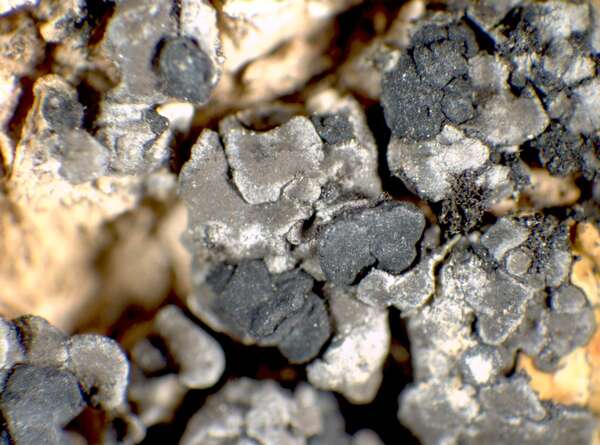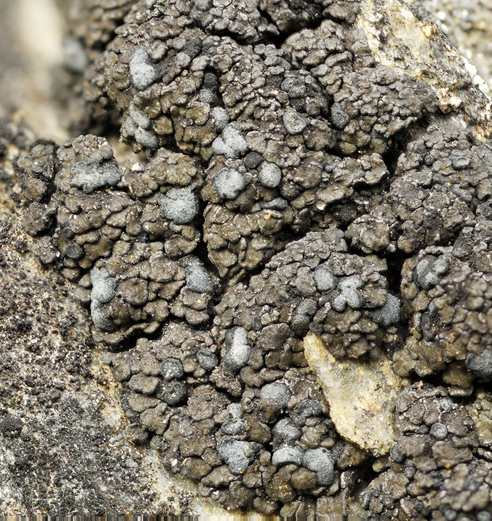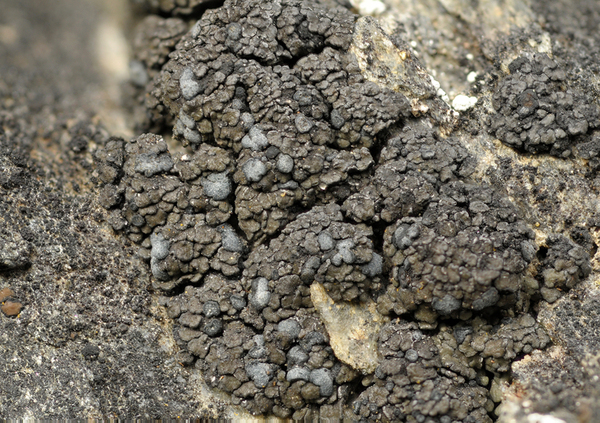Toninia cinereovirens (Schaer.) A. Massal.
Ric. Auton. Lich. Crost.: 107, 1852. Basionym: Lecidea cinereovirens Schaer. - Lich. Helv. Spicil., 3: 109, 1828.
Synonyms: Bilimbia cinereovirens (Schaer.) Jatta; Bilimbia fallasca (A. Massal.) Jatta; Bilimbia nigrescens (Anzi) Jatta; Toninia fallasca A. Massal.; Toninia nigrescens Anzi; Toninia olivaceoatra H. Magn.; Toninia potieri Maheu & Werner; Toninia sbarbaronis B. de Lesd.
Description: Thallus squamulose, forming irregular, up to 4 cm wide patches, the squamules brown to dark brown, sometimes with a dark grey margin, epruinose, dull to somewhat shiny, up to 3 mm wide, weakly concave to convex, contiguous to slightly imbricate, often deeply lobed, the cortex sometimes with shallow fissures; lower surface brown. Upper cortex 60-100 μm thick, including an up to 40 μm thick epinecral layer lacking crystals; medulla white, lacking crystals; lower cortex poorly developed. Apothecia frequent, lecideine, sessile, flat to convex, 0.7-1 mm across, black, but sometimes faintly pruinose on disc. Proper exciple colourless in inner part, dark brown in outer part, K-, N-; epithecium olivaceous brown to blue-green, K-, N+ violet; hymenium colourless, 60-70 μm high; paraphyses simple or sparingly branched and anastomosing, not conglutinated, the apical cell distinctly swollen and covered by a gelatinous pigment cap; hypothecium pale brown to colourless. Asci 8-spored, clavate, surrounded by a gelatinous I+ blue coat, with a well-developed I+ blue tholus, a I+ darker blue tube and a well-developed ocular chamber, Bacidia-type. Ascospores 1-3-septate, hyaline, ellipsoid to bacilliform, 13-32 x 3-4.5 μm. Pycnidia partly projecting with a black ostiole. Conidia filiform. Photobiont chlorococcoid. Spot tests: thallus K-, C-, KC-, P-, UV-. Chemistry: thallus without lichen substances.
Growth form: Squamulose
Substrata: rocks
Photobiont: green algae other than Trentepohlia
Reproductive strategy: mainly sexual
Subcontinental: restricted to areas with a dry-subcontinental climate (e.g. dry Alpine valleys, parts of Mediterranean Italy)
On otherwise dry surfaces with short periods of water seepage after rain
Commonnes-rarity: (info)
Alpine belt: absent
Subalpine belt: extremely rare
Montane belt: rather rare
Dry submediterranean belt: rare
Humid submediterranean belt: rather rare
Padanian area: absent
pH of the substrata:
1 2 3 4 5
Solar irradiation:
1 2 3 4 5
Aridity:
1 2 3 4 5
Eutrophication:
1 2 3 4 5
Poleotolerance:
0 1 2 3
Altitudinal distribution:
1 2 3 4 5 6
Rarity
absent
extremely rare
very rare
rare
rather rare
rather common
common
very common
extremely common
Loading data...
Occurrence data
Predictive map

P.L. Nimis; Owner: Department of Life Sciences, University of Trieste
Herbarium: TSB (13195)
2001/12/01

Collezione lichenologica Abramo Massalongo del Museo di Storia Naturale G. Ligabue di Venezia - Autori: Seggi, Linda; Trabucco, Raffaella Proprietà: Fondazione Musei Civici di Venezia - CC BY-NC
Italy, Veneto, in opp. Auronzo 1855

Collezione lichenologica Abramo Massalongo del Museo di Storia Naturale G. Ligabue di Venezia - Autori: Seggi, Linda; Trabucco, Raffaella Proprietà: Fondazione Musei Civici di Venezia - CC BY-NC
Italy, Veneto, in oppido Grezzana (Fallasco) 1855
as Toninia fallasca
Growth form: Squamulose
Substrata: rocks
Photobiont: green algae other than Trentepohlia
Reproductive strategy: mainly sexual
Subcontinental: restricted to areas with a dry-subcontinental climate (e.g. dry Alpine valleys, parts of Mediterranean Italy)
On otherwise dry surfaces with short periods of water seepage after rain
Commonnes-rarity: (info)
Alpine belt: absent
Subalpine belt: extremely rare
Montane belt: rather rare
Dry submediterranean belt: rare
Humid submediterranean belt: rather rare
Padanian area: absent
pH of the substrata:
| 1 | 2 | 3 | 4 | 5 |
Solar irradiation:
| 1 | 2 | 3 | 4 | 5 |
Aridity:
| 1 | 2 | 3 | 4 | 5 |
Eutrophication:
| 1 | 2 | 3 | 4 | 5 |
Poleotolerance:
| 0 | 1 | 2 | 3 |
Altitudinal distribution:
| 1 | 2 | 3 | 4 | 5 | 6 |
Rarity
absent
extremely rare
very rare
rare
rather rare
rather common
common
very common
extremely common
Loading data...
Occurrence data
Predictive map

P.L. Nimis; Owner: Department of Life Sciences, University of Trieste
Herbarium: TSB (13195)
2001/12/01

Collezione lichenologica Abramo Massalongo del Museo di Storia Naturale G. Ligabue di Venezia - Autori: Seggi, Linda; Trabucco, Raffaella Proprietà: Fondazione Musei Civici di Venezia - CC BY-NC
Italy, Veneto, in opp. Auronzo 1855











